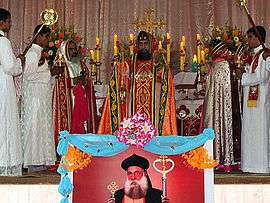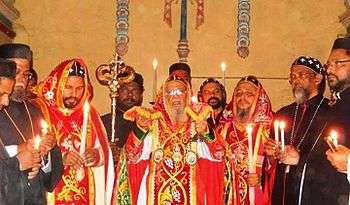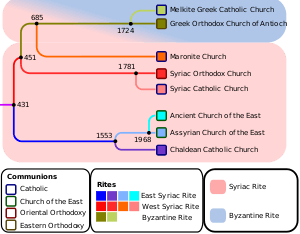West Syriac liturgical rites
West Syriac liturgical rites, also known as West Syrian, Jacobite, or Antiochene liturgical rites, are the liturgical rites practiced by churches following the West Syriac tradition of Syriac Christianity. These rites developed out of the ancient Antiochene Rite of the Patriarchate of Antioch, adapting the old Greek liturgy into Syriac, the language of the Syrian countryside.
West Syriac liturgies represent one of the major strains in Syriac Christianity, the other being the East Syriac Rite, the liturgy of the Church of the East and its descendants. Distinct West Syriac liturgies developed following the Council of Chalcedon (451), which largely divided the Christian community in Antioch into Melkites, who supported the Emperor and the Council and adopted the Byzantine Rite, and the non-Chalcedonians, who rejected the council and developed an independent liturgy – the West Syriac Rite. An independent West Syriac community that grew around the monastery of Saint Maron eventually developed into the Maronite Church, which uses its own Maronite Rite. A variant of the West Syriac Rite, the Malankara Rite, developed in the Malankara Church of India and is still used in its descendant churches.
Rites
Today, the surviving West Syriac liturgical rites are:
- The West Syriac Rite – used in the Syriac Orthodox Church and the Syriac Catholic Church
- Malankara Rite – used historically in the Malankara Church; now used in the Malankara Orthodox Syrian Church, the Jacobite Syrian Christian Church, the Malabar Independent Syrian Church, the Malankara Mar Thoma Syrian Church, and the Syro-Malankara Catholic Church
- The Maronite Rite – used in the Maronite Church
Gallery
 West Syriac Rite liturgy of Syro-Malankara Catholic Church
West Syriac Rite liturgy of Syro-Malankara Catholic Church West Syriac Rite Liturgy of the Jacobite Syrian Christian Church
West Syriac Rite Liturgy of the Jacobite Syrian Christian Church
References
- Chupungco, Anscar J. (1997). Handbook for Liturgical Studies. Liturgical Press. ISBN 0-8146-6161-0. Retrieved April 5, 2010.
- King, Archdale (2007). The Rites of Eastern Christendom. 1. Gorgias Press LLC. ISBN 1-59333-391-9. Retrieved April 5, 2010.
- Wainwright, Geoffrey; Karen Beth Westerfield Tucker (2006). The Oxford History of Christian Worship. Oxford University Press. ISBN 0-19-513886-4. Retrieved April 5, 2010.


